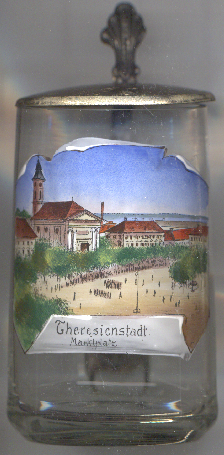

|
| ČESKÁ REPUBLIKA | CZECH REPUBLIC |
| Ústecký kraj | Ústí nad Labem region |
| Okres: Litoměřice |
Terezín (German: Teresienstadt) is situated at an elevation of 150 m at the river Ohře (Eger) shortly upstream of its confluence with the Labe (Elbe), about 3 km south of the district town Litoměřice and about 18 km southeast of the regional capital, Ústí nad Labem. The municipality has a population of about 2,900 (2023).
 On 10 January 1780, Habsburg Emperor Joseph II ordered the erection of the fortress, named Theresienstadt after his mother
Maria Theresa of Austria. In the times of Austria–Prussia rivalry, it was meant to secure the bridges across the Ohře and Elbe
rivers against Prussian troops invading the Bohemian lands from neighbouring Saxony. Simultaneously, Josephstadt Fortress
(Josefov) was erected near Jaroměř, also as a protection against
Prussian attacks. The construction of Theresienstadt started on 10 October 1780 and lasted ten years. During the construction, in 1782,
Theresienstadt became a free royal town. The fortress consisted of a citadel, the "Small Fortress", to the east of the Ohře, and a walled
town, the "Main Fortress", to the west. The total area of the fortress was 3.89 km². In peacetime it held 5,655 soldiers, and in
wartime around 11,000 soldiers could be placed here. Trenches and low-lying areas around the fortress could be flooded for defensive purposes.
During the second half of the 19th century, the fortress was also used as a prison. During World War I, the fortress was used as a
political prison camp. With the collapse of Austria-Hungary in 1918, the town became part of the newly-formed state of Czechoslovakia.
On 10 January 1780, Habsburg Emperor Joseph II ordered the erection of the fortress, named Theresienstadt after his mother
Maria Theresa of Austria. In the times of Austria–Prussia rivalry, it was meant to secure the bridges across the Ohře and Elbe
rivers against Prussian troops invading the Bohemian lands from neighbouring Saxony. Simultaneously, Josephstadt Fortress
(Josefov) was erected near Jaroměř, also as a protection against
Prussian attacks. The construction of Theresienstadt started on 10 October 1780 and lasted ten years. During the construction, in 1782,
Theresienstadt became a free royal town. The fortress consisted of a citadel, the "Small Fortress", to the east of the Ohře, and a walled
town, the "Main Fortress", to the west. The total area of the fortress was 3.89 km². In peacetime it held 5,655 soldiers, and in
wartime around 11,000 soldiers could be placed here. Trenches and low-lying areas around the fortress could be flooded for defensive purposes.
During the second half of the 19th century, the fortress was also used as a prison. During World War I, the fortress was used as a
political prison camp. With the collapse of Austria-Hungary in 1918, the town became part of the newly-formed state of Czechoslovakia.
After the Munich Agreement of 1938, Nazi Germany annexed the town with the rest of the Sudetenland, followed by the rest of Czechoslovakia in 1939. With the existing prisons gradually filled up as a result of the Nazi terror, the Prague Gestapo Police prison was set up in the Small Fortress in 1940. The Jewish Ghetto of Theresienstadt was created in 1941. Although it was not an extermination camp, about 33,000 died in the ghetto. This was mostly due to the appalling conditions arising out of extreme population density, malnutrition and disease. About 88,000 inhabitants were deported to Auschwitz and the other extermination camps. The complex was taken over for operation by the International Red Cross on 2 May 1945; the camp and prison were liberated one week later by the Soviet Army. In 2002, the fortress, which was in a deteriorated condition, was listed in the 2002 World Monuments Watch by the World Monuments Fund. A conservation plan was eventually developed in cooperation with national authorities.
The  garrison church of the Resurrection of Christ [left] was built in 1805–1810 in
Empire style by the architects Heinrich Hatzinger, Julius D'Andreis and Franz Joseph Fohmann.
garrison church of the Resurrection of Christ [left] was built in 1805–1810 in
Empire style by the architects Heinrich Hatzinger, Julius D'Andreis and Franz Joseph Fohmann.
[https://de.wikipedia.org/wiki/Terez%C3%ADn, https://en.wikipedia.org/wiki/Terez%C3%ADn]
![[scale]](lineal.jpg)